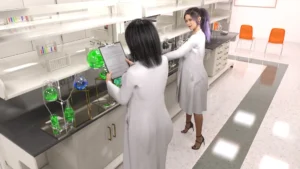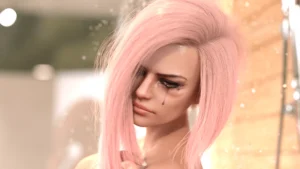
Having a HARD Time
Play Having a HARD Time
Having a HARD Time review
A Deep Dive into the Visual Novel
In the realm of visual novels, ‘Having a HARD Time’ stands out for its unique blend of science and personal drama. This game follows a young girl whose life is turned upside down after a science experiment goes awry. With its engaging storyline and complex characters, ‘Having a HARD Time’ offers an immersive experience that explores themes of identity and resilience.
Understanding the Game’s Narrative
Understanding the Game’s Narrative
Ever played a visual novel that grabs your heart and won’t let go? 😮💨 That’s “Having a HARD Time” for you! This isn’t just another dating sim—it’s a rollercoaster narrative where a brilliant student’s life implodes after a lab disaster. The visual novel plot hooks you immediately with its raw take on consequences, making you ask: “What would I do if everything I knew about myself shattered overnight?” 💥
The Science Experiment Gone Wrong
Picture this: Alex (our genius protagonist) just wants to ace her quantum physics project. 🔬 But one miscalculation turns her world into chaos! The science experiment gone wrong isn’t just a plot device—it’s the wrecking ball that demolishes her identity. One minute she’s analyzing data, the next she’s physically transforming against her will. 😱
Pro Tip: Pay attention to lab scenes! They foreshadow how tiny choices spiral into life-altering consequences.
For example, Alex’s hands start flickering between solid and ethereal states during class. Panicked, she hides in bathrooms, skipping meals to avoid questions. 😔 This isn’t sci-fi fluff—it’s a gut-punch exploration of losing control. The accident forces her into isolation, straining friendships as she lies about “allergies” and “sleep deprivation.” What makes this visual novel plot genius? It uses the science experiment gone wrong to mirror real-life crises—like illness or trauma—where your body betrays you. 💔
Here’s how the experiment reshapes her reality:
| Before Accident | After Accident |
|---|---|
| Top student, socially active | Academic probation, social withdrawal |
| Clear career ambitions | Identity confusion, purpose loss |
| Trusting relationships | Paranoia, secrecy |
Character Development and Relationships
Alex’s transformation drives the character development in visual novels to masterful heights. 🎭 Early on, she’s prideful and dismissive—until the accident forces humility. Watching her beg for help from rivals she once mocked? Chilling. Her relationships evolve in three heartbreaking phases:
- Denial 😤 (“I’ll fix this alone!”)
- Vulnerability 😢 (“Why won’t my body listen?”)
- Acceptance 🤝 (“I need you.”)
Her lab partner, Marco, starts as a smug competitor but becomes her reluctant guardian. Their dynamic shines a light on narrative depth in visual novels—how crisis exposes true colors. 💙 When Marco covers for Alex during a public meltdown, you see his guilt over the experiment. It’s not just romance; it’s shared trauma forging unexpected bonds.
Family interactions hit harder. Alex’s mom keeps texting, “Why don’t you call?” 😞 Those missed calls pile up, showing how shame isolates us. This character development in visual novels works because every interaction:
– Reveals hidden fears
– Tests loyalty
– Forces characters (and players) to confront uncomfortable truths
Themes of Identity and Resilience
Who are you when your dreams crumble? 🧩 “Having a HARD Time” weaponizes this question through themes of identity in games. Alex’s journey isn’t about “fixing” herself—it’s about rebuilding from ashes. Her resilience isn’t heroic; it’s messy. She fails exams, snaps at friends, and soars in therapy sessions. 🛋️✨
The game mirrors real struggles like:
– Chronic illness (“Is this my body now?”)
– Career loss (“What if I can’t be a scientist?”)
– Self-worth beyond achievements
Resilience in storytelling here feels earned because Alex’s growth is non-linear. One day she’s hopeful, the next she’s smashing beakers! 💥 This honesty makes her protagonist’s journey in visual novels relatable. Her victory isn’t a cure—it’s learning to say, *”I’m more than my broken parts.”_
Fun detail: Alex’s wardrobe shifts from lab coats to comfy sweaters—a visual metaphor for embracing imperfection.
The narrative depth in visual novels shines when side characters challenge themes. Her stern professor admits, *”I quit medicine after losing a patient.”_ 👴 This moment reframes resilience—not as bouncing back, but as evolving.
Ultimately, “Having a HARD Time” crafts a visual novel plot that lingers. Its science experiment gone wrong isn’t just spectacle—it’s a catalyst for exploring how we rebuild identities. Through Alex’s stumbles and breakthroughs, the game proves resilience in storytelling means embracing scars, not erasing them. 🌟 Whether you’re here for the character development in visual novels or the raw themes of identity in games, this journey reminds us: sometimes falling apart is how we learn to stand taller. 💪
In conclusion, ‘Having a HARD Time’ offers a compelling narrative that explores complex themes and character development. By delving into the protagonist’s journey and the impact of the science experiment, players can experience a rich and immersive story. For those interested in visual novels with deep storytelling, ‘Having a HARD Time’ is certainly worth exploring.





















